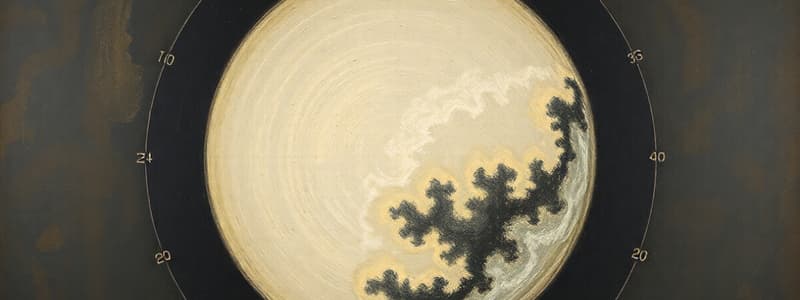Podcast
Questions and Answers
If a circle's area is $25\pi$, what is its circumference?
If a circle's area is $25\pi$, what is its circumference?
- $5\pi$
- $25\pi$
- $50\pi$
- $10\pi$ (correct)
How does the general equation of a circle, $Ax^2 + Cy^2 + Dx + Ey + F = 0$, relate to the standard equation?
How does the general equation of a circle, $Ax^2 + Cy^2 + Dx + Ey + F = 0$, relate to the standard equation?
- The general equation is a simplified form of the standard equation, useful for quick calculations.
- The general equation can always be directly converted to the standard equation by rearranging terms.
- There is no direct relationship between general and standard equation of the circle.
- The general equation is derived from the standard equation through algebraic simplification and expansion. (correct)
Given the equation of a circle is $(x-3)^2 + (y+2)^2 = 16$, what are the coordinates of the center and the length of the radius?
Given the equation of a circle is $(x-3)^2 + (y+2)^2 = 16$, what are the coordinates of the center and the length of the radius?
- Center: (3, -2), Radius: 4 (correct)
- Center: (-3, 2), Radius: 16
- Center: (-3, 2), Radius: 4
- Center: (3, -2), Radius: 16
What distinguishes a 'unit circle' from other circles?
What distinguishes a 'unit circle' from other circles?
If a circle is tangent to a line, what is true at the point of tangency?
If a circle is tangent to a line, what is true at the point of tangency?
Which of the following is the standard equation of a circle with center (h, k) and radius r?
Which of the following is the standard equation of a circle with center (h, k) and radius r?
What is the general form of a circle's equation?
What is the general form of a circle's equation?
How do you find the equation of a circle given three points on its circumference?
How do you find the equation of a circle given three points on its circumference?
If the diameter of a circle is 14 units, what is its area?
If the diameter of a circle is 14 units, what is its area?
What does it mean for a point to be 'equidistant' from a fixed point when defining a circle?
What does it mean for a point to be 'equidistant' from a fixed point when defining a circle?
Given the general equation of a circle $x^2 + y^2 + 4x - 6y - 12 = 0$, what is the radius of the circle?
Given the general equation of a circle $x^2 + y^2 + 4x - 6y - 12 = 0$, what is the radius of the circle?
How does completing the square help in transforming the general equation of a circle to its standard form?
How does completing the square help in transforming the general equation of a circle to its standard form?
If a circle has a circumference of $6\pi$, what is the length of its radius?
If a circle has a circumference of $6\pi$, what is the length of its radius?
How does increasing the radius of a circle affect its circumference and area?
How does increasing the radius of a circle affect its circumference and area?
What is the equation of a circle centered at the origin with a radius of 7?
What is the equation of a circle centered at the origin with a radius of 7?
If the equation of a circle is $(x - a)^2 + (y - b)^2 = r^2$, what geometric feature does the ordered pair (a, b) represent?
If the equation of a circle is $(x - a)^2 + (y - b)^2 = r^2$, what geometric feature does the ordered pair (a, b) represent?
How does transforming the general equation of a circle to the standard equation aid in graphing the circle?
How does transforming the general equation of a circle to the standard equation aid in graphing the circle?
What condition must be met for an equation in the form of $Ax^2 + Cy^2 + Dx + Ey + F = 0$ to represent a circle?
What condition must be met for an equation in the form of $Ax^2 + Cy^2 + Dx + Ey + F = 0$ to represent a circle?
Given a circle centered at (2, -3) that passes through the point (5, 1), what is the square of the radius of the circle?
Given a circle centered at (2, -3) that passes through the point (5, 1), what is the square of the radius of the circle?
Consider the line 2x + y = 6 and x - y = 3 intersect at a point. If this point serves as the center for a circle with a radius of 4 units, what is the general equation of this circle?
Consider the line 2x + y = 6 and x - y = 3 intersect at a point. If this point serves as the center for a circle with a radius of 4 units, what is the general equation of this circle?
Flashcards
What is a Circle?
What is a Circle?
A set of points equidistant from a center.
What is a Radius?
What is a Radius?
Distance from the center to any point on a circle.
What is Circumference?
What is Circumference?
The distance around the circle.
What is a Unit Circle?
What is a Unit Circle?
Signup and view all the flashcards
What is Area of a circle?
What is Area of a circle?
Signup and view all the flashcards
What is Point of Tangency?
What is Point of Tangency?
Signup and view all the flashcards
What is standard Equation of a Circle?
What is standard Equation of a Circle?
Signup and view all the flashcards
What is General Equation of a Circle?
What is General Equation of a Circle?
Signup and view all the flashcards
Circle equation at the Origin
Circle equation at the Origin
Signup and view all the flashcards
Study Notes
- A circle is formed when the cutting plane is parallel to the base of the conic section
- A circle is the locus of points P(x, y) that are equidistant from a fixed point
- The fixed point of a circle is called the center
- The fixed distance is called the radius
- Radius is the distance from the center to any point on the circle
- The distance around the circle is called the circumference
- Area of a circle: A = πr²
- Circumference of a circle: C = 2πr
Equation of a Circle at the Origin
- The segment from the center to a point on the circle is called the radius
- The radius of the circle represented by segment CP can be calculated using the distance formula: CP = √(x₂ − x₁)² + (y₂ − y₁)²
- Given C(0, 0) as P₁ and P(x, y) as P₂, the radius is r = √(x₂ − x₁)² + (y₂ − y₁)²
- Simplified: r = √(x − 0)² + (y − 0)²
- Further simplified: r = √x² + y²
- Squaring both sides gives: x² + y² = r²
- The equation of a circle whose center is at the origin is x² + y² = r²
Equation of a Circle with Center at (h, k)
- If the center is at (h, k), the radius is r = √(x₂ − x₁)² + (y₂ − y₁)²
- The equation of a circle with center (h, k) and radius r is: (x − h)² + (y − k)² = r²
Standard and General Equation
- (x − h)² + (y − k)² = r² is the standard equation of a circle with center C(h, k) and radius r, also known as the center-radius form
- Simplifying (x − h)² + (y − k)² = r² yields: x² − 2hx + h² + y² − 2ky + k² = r²
- Rearranging: x² + y² − 2hx − 2ky + (h² + k² − r²) = 0
- This can be rewritten as Ax² + Cy² + Dx + Ey + F = 0 (general equation), where h, k, and r are constants
- A unit circle is a circle with a radius of one, represented by the equation x² + y² = 1
Converting General Equation to Standard Equation
- To express the general equation to standard equation of a circle, apply the following steps:
- Put the x related terms together and y related terms together. Transpose the constant term to the other side of the equation
- Perform completing the square by inserting the needed values for creating the perfect square trinomials by taking half of the middle term and squaring it. The value will always be positive as a result of the squaring process
- Balance both sides of the equation
- Express the perfect square trinomials as the square of binomials
Studying That Suits You
Use AI to generate personalized quizzes and flashcards to suit your learning preferences.


